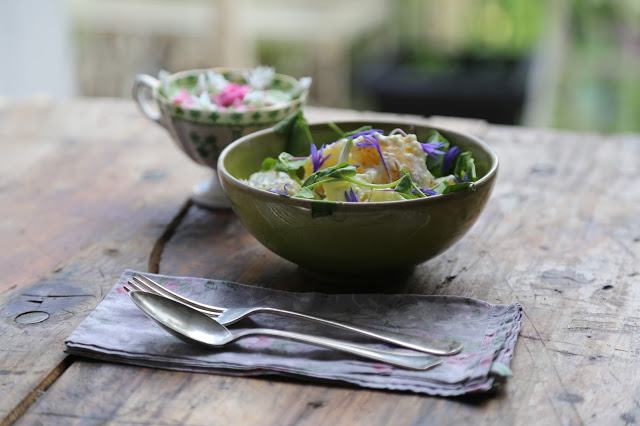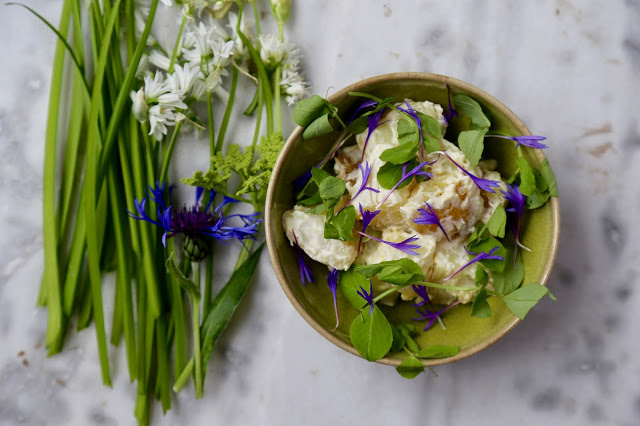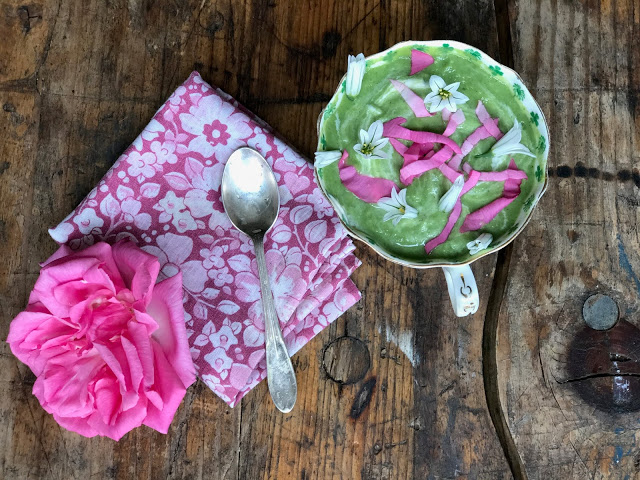At the end of May, London enjoys seasonal fixture the Chelsea Flower Show. While it’s early in the season for edible flowers, don’t forget them as flavourful and beautiful enhancements for your food. Three-cornered leeks, cornflowers and roses, all of which are edible, are currently blooming in my garden.
Tips for using edible flowers:
- Picking flowers for eating is much like identifying fungi: ensure you know exactly what the flower is, don’t make assumptions.
- Don’t use poisonous flowers such as anything from the nightshade family (potatoes, aubergines, peppers).
- Take into account where you found it: for instance don’t pick flowers by the roadside where they have been subjected to car fumes or pets.
- Pick only unsprayed flowers from a trusted garden rather than from supermarkets or flower shops.
- Only use flowers in prime condition.
- Remember you won’t get fruit if you eat the flowers of courgettes, beans and squash (but they are so delicious you may want to sacrifice a few vegetables).
- It’s best to pick in late morning: the dew will have lifted so they aren’t soggy, but the sun won’t have started to dry out the petals.
- Watch out for bugs: enclose the flowers in a paper bag and most insects will crawl out. For edibles like courgette flowers, prise open the flower carefully and look inside.
- Remove the stamen from larger flowers.
- Cut off the bitter white part of the rose petal.
- If you are unused to eating flowers, don’t eat too many.
Flowers to try:
Violas and violets are good for decoration, crystallisation and scent.
Day lilies can be steamed. Their blazing colours are great in stir fries.
Borage for decorating salads and drinks. In the Middle East it’s used as a tea.
Nasturtiums are well known, adding a peppery colour to salads.
Marigold petals are good for your skin and excellent scattered over bread, or salads.
Courgette flowers, stuff with soft cheese and deep fry.
Squash flowers make a traditional Mexican soup.
Pinks have petals which can be used as edible decoration.
Rose petals: rose was ubiquitous before the importation of vanilla. Use the flavour sparingly. For use in baking, to grind with spices to make Ras el Hanout or rose harissa.
Geranium flowers and leaves to use in salads.
Pelargoniums: you can use the scented leaves (some are rose or lemon scented) to line sponge cakes.
Bean flowers which taste just like the raw bean itself (but not sweet peas).
Crocus stamens are of course one of the world’s most treasured spices, saffron.
Hibiscus flowers make a refreshing drink when infused in water and also lower blood pressure. They are used as an ingredient in Mexican cooking, to stuff enchiladas.
Elderflowers, fried in delicate batter, used as a syrup over ice creams and cheese cake.
Herb flowers:
Mauve chive flowers to flavour and add colour to soft cheeses.
Rosemary blossoms are a good addition to garlic mushrooms.
Lavender flowers for flavouring sugar or cakes.
Thyme flowers can be added to pasta dishes.
Recipes:
Three cornered leek and cornflower potato salad

Serves 4-6
2kg new potatoes, scrubbed, skins left on
50g salted butter
Three cornered leek leaves or wild garlic leaves, shredded
300ml sour cream
1tbsp salt
A large handful of pea shoots
Garnish:
Cornflower petals or, later in the year, fennel flowers which add a lovely aniseed flavour.
Method:
Boil the potatoes in salty water for 20 minutes or until tender. I don’t peel new potatoes, the goodness is in the thin skins.
Strain and mix with butter.
Add the leaves and the sour cream.
Season and garnish.
Rose and cucumber chilled soup
This is a refreshing summer soup, an English gazpacho if you will.
Serving suggestion: serve in pretty teacups.
Ingredients:
2 large cucumbers
300ml plain yogurt (or creme fraiche)
Juice 1/2 lemon
Handful of wild garlic leaves if in season or 1 garlic clove, minced
30ml olive oil, plus more for drizzling
Salt
Fresh ground white pepper
To garnish:
Rose petals, white tip removed, rolled up and cut in a ‘chiffonade’
Wild garlic flowers or 3 cornered leek flowers
Method:
In a blender, combine the cucumber with the yogurt, lemon juice, wild garlic, and olive oil. Blend until smooth. Season with salt and white pepper, cover and refrigerate for 2 hours.
Season the soup again just before serving. Pour the soup into bowls. Garnish with the rose petals and wild garlic flowers.






Use the male courgette flowers. They don't have a little courgette starting to develop at the stem end..
I've been bypassing most flowers all these years.